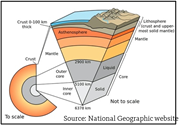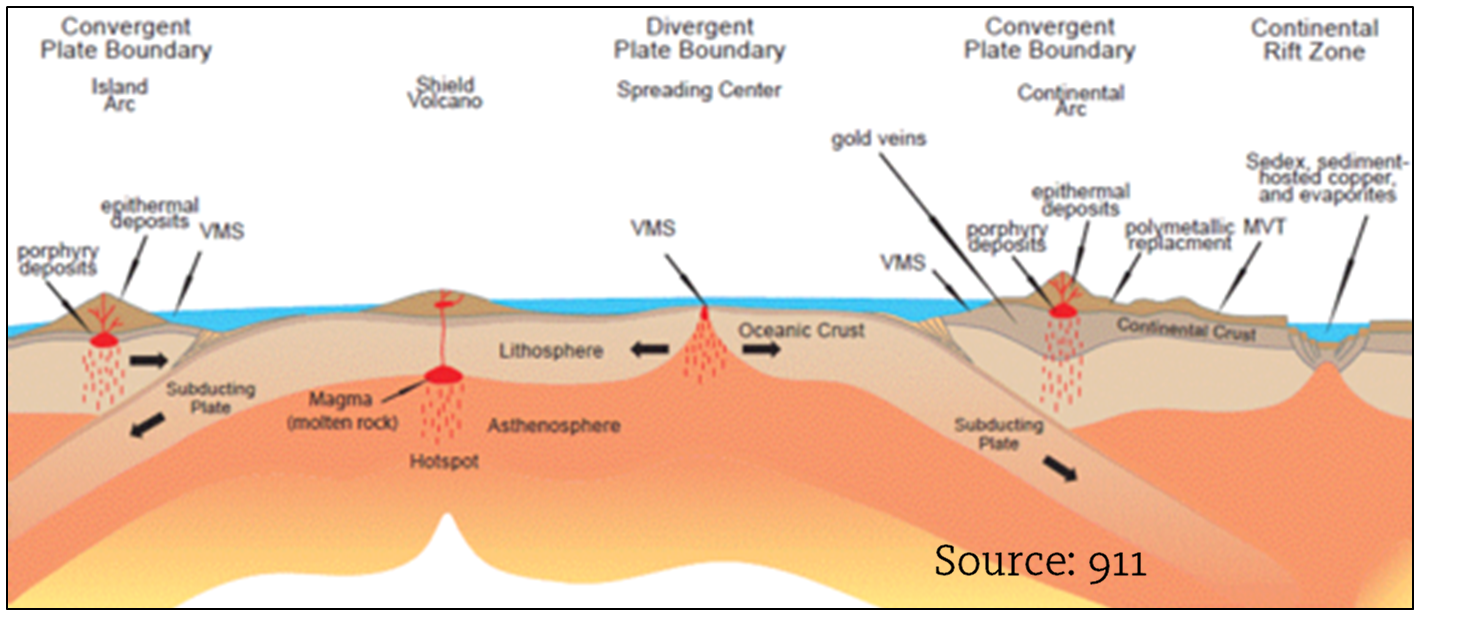Origins of Metals & How Ore Deposits are Formed
The focus of the last two Outlooks has been a high-level overview of commodity cycles but moving forward, we will shift focus to discuss where these metals actually originate and how mineral deposits are formed. Nearly 4.5 billion years ago during the initial stages of Earth’s formation, gravity pulled swirling gas and dust, laden with elements, together to form our planet. During this process the denser molten iron sank to the centre and formed the core and along with it took the majority of Earth’s denser precious metals (Au, Ag, Pt, Pd, etc.) while leaving lighter elements (Si, C, and O) to form the mantle and crust. It’s hypothesized that the core contains enough precious metals to cover the entire surface of the planet with a four-metre thick layer. Thus, we would expect that the Earth’s crust would be devoid of metals. Matter of fact, the outer layers were, until about 4 billion years ago when metal rich meteorites bombarded the Earth after the formation of the core, re-introducing the metals (we mine today) back into the crust.
Despite this re-introduction, the concentrations of metals are not economical unless they have been concentrated through natural processes (subduction, crustal thickening) that cause partial melting in crustal rocks. Large plumes of magma rise through the crust leaching the metals, which are in concentrations of parts per million, out of the surrounding rocks. As the magma rises, the surrounding pressure begins to drop and the metal laden magma begins to cool and separate. It’s at this stage, where precious metals and industrial metals (Cu, Zn, Pb, etc.) preferentially separate. Metals such as Ni and Pt will crystallize first and sink to the bottom of the magma chamber, while metals such as copper will be taken up into a brine solution and be deposited towards the top of the magma chamber forming porphyry deposits.

Gold, on the other hand, typically occurs as a gas or an aqueous phase and will escape upward forming epithermal style deposits as it fractures the rocks at surface causing rapid cooling and formation of veins. If the magma body occurs below the ocean within the oceanic crust, VMS (polymetallic) deposits will form which are analogous to present day black smokers.

There are a number of different deposits types and we have only touched on the main ones; however, the principle is generally the same as described. The difference occurs due to depth of emplacement which is a function of metals precipitating out due to varying pressures and temperatures, and where these fluids are eventually deposited.
“This means that” if it can’t be grown, it has to be mined. Precious and industrial minerals are ubiquitous in the earth’s crust; however, these minerals need to be concentrated in large enough quantities to be economical. This enrichment process leaves clues that allow Geologists to vector towards prospective areas where a deposit may occur.
National Instrument 31-103 requires registered firms to disclose information that a reasonable investor would expect to know, including any material conflicts with the firm or its representatives. Doug Johnson and/or Pathfinder Asset Management Limited are an insider of companies periodically mentioned in this report. Please visit www.paml.ca for full disclosures.
*All returns are time weighted and net of investment management fees. Returns from the Pathfinder Partners’ Fund and Partners’ Real Return Plus Fund are presented based on the masters series of each fund. The Pathfinder Core: Equity Portfolio and The Pathfinder Core: High Income Portfolio are live accounts. These are actual accounts owned by the Pathfinder Chairman (Equity) and client (High Income) which contain no legacy positions, cash flows or other Pathfinder investment mandates or products. Monthly inception dates for each fund and portfolio are as follows: Pathfinder North American: Equity Portfolio (January 2011), Pathfinder North American: High Income Portfolio (October 2012) Pathfinder Partners’ Fund (April 2011), Pathfinder Real Return Plus Fund (April, 2013), Pathfinder International Fund (November 2014) and Pathfinder Resource Fund (May 2018).
Pathfinder Asset Management Limited (PAML) and its affiliates may collectively beneficially own in excess of 10% of one or more classes of the issued and outstanding equity securities mentioned in this newsletter. This publication is intended only to convey information. It is not to be construed as an investment guide or as an offer or solicitation of an offer to buy or sell any of the securities mentioned in it. The author has taken all usual and reasonable precautions to determine that the information contained in this publication has been obtained from sources believed to be reliable and that the procedures used to summarize and analyze such information are based on approved practices and principles in the investment industry. However, the market forces underlying investment value are subject to sudden and dramatic changes and data availability varies from one moment to the next. Consequently, neither the author nor PAML can make any warranty as to the accuracy or completeness of information, analysis or views contained in this publication or their usefulness or suitability in any particular circumstance. You should not undertake any investment or portfolio assessment or other transaction on the basis of this publication, but should first consult your portfolio manager, who can assess all relevant particulars of any proposed investment or transaction. PAML and the author accept no liability of any kind whatsoever or any damages or losses incurred by you as a result of reliance upon or use of this publication.